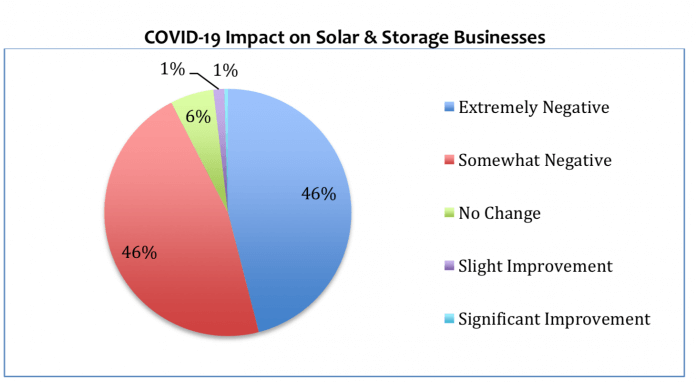COVID-19 has negatively impacted 92% of California’s solar+storage companies. Half of the affected companies reported the impact to be extremely negative, and the other half characterized it as somewhat negative, according to a recent survey conducted by the California Solar & Storage Association (CALSSA).
Responses were received from 212 companies between April 16-21, approximately one month after the statewide shelter-in-place order was declared on March 19. Responding companies included residential installers, commercial project developers, engineering firms, financiers and manufacturers within the distributed solar photovoltaic, solar heating and cooling, and energy storage markets.
Twenty-four percent of the respondents reported that they had laid off or furloughed their entire workforce. Another 46% had implemented layoffs, furloughs and/or pay cuts for some portion of their employees. Only 30% of businesses reported being able to continue to employ their entire workforce at full pay.
Job loss appears to be hitting smaller businesses harder. Businesses that had 6-10 employees have laid off 44% of their employees, while businesses that had more than 150 employees have let go 15% of their employees. These results do not mean that large businesses have not suffered under COVID-19 but rather that small businesses might be particularly susceptible to sudden changes in the marketplace.
The reasons for a reduction in sales hinge mostly on customers not wanting to engage during the health crisis and government entities and utilities not allowing the activity. CALSSA expects customer disengagement to rebound. Facilitating online permitting and inspections will be increasingly important.
Pre-COVID-19, California averaged 400 residential solar installations per day. From the point of initial customer contact to interconnection, most residential projects can be completed within a matter of weeks. In addition, pre-COVID-19 California was averaging more than 200 large, commercial projects per month. While these larger projects, such as school and farm installations, are more complex and require advanced design and engineering, even these projects can be shovel ready within months. California’s public schools could see the installation of solar and energy storage on at least 2,000 K-12 school sites in the next few years.
If workforce is not regained quickly, pipelines will fade. The longer it takes to resume full business activity, the harder it will be to reach pre-COVID-19 levels. It is difficult to hire people if there is not an existing pipeline of projects, and it is hard to develop a pipeline of projects without employees.
Many workers’ current unemployment is termed “furlough” but does set a definitive date to return to work. Employers in these cases have good intentions to hire back their trained workers, but without firm plans for an end to the unemployment, workers will commit to other jobs.
To read CALSSA’s full report on COVID-19’s impact on California’s solar+storage industry, click here.




